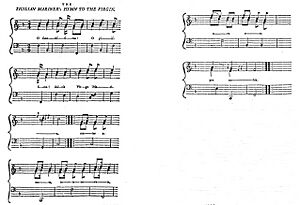O sanctissima facts for kids
"O sanctissima" means "O most holy" in Latin. It is a Catholic hymn. People sing it to ask for prayers from the Blessed Virgin Mary. It is often sung on special days that honor Mary.
The first time this hymn was published was in London in 1792. It was said to be a traditional song from Sicily, an island in Italy. But no one knows exactly when or where the simple tune or the words first came from. The tune is often called the "Sicilian Mariners Hymn". This name comes from sailors who would pray to Mary at night for protection. They saw her as their loving protector, like Our Lady, Star of the Sea.
This tune has been used for other famous songs. These include the German Christmas carol "O du fröhliche" (meaning "O, how joyful"). It's also used for the English hymn "Lord, Dismiss Us With Thy Blessing". The first part of the American civil rights song "We Shall Overcome" also uses this tune.
Other Latin songs with similar words have been made since the 1500s. Famous composers like E.T.A. Hoffmann and Antonín Dvořák created their own versions.
Contents
What the Latin Words Mean
Here are the words of the hymn in Latin and what they mean in English. Many different versions of these words exist.
|
O sanctissima, o piissima, |
O most holy, o most loving, |
The first lines of this Latin hymn are similar to the end of a very old prayer from the 12th century called Salve Regina. That prayer ends with: "O clemens, O pia, O dulcis Virgo Maria." Some old books say these words were carved at Speyer Cathedral a long time ago, even when Saint Bernard of Clairvaux (who lived from 1090 to 1153) was alive.
How the Hymn Became Popular
"O sanctissima" was first published as "The Prayer of the Sicilian Mariners". It appeared in a book by Edward Jones. This book included music for voice and harp. His book was likely published around 1790.
The hymn was also printed in the European Magazine in 1792. Then, an American magazine published it in 1794. By the early 1800s, "O sanctissima" was becoming very popular. People were singing it in many different languages.
Famous composers like Joseph Haydn and Ludwig van Beethoven even created their own versions of the Latin hymn for choirs.
A Christmas Carol
Around 1816, a German version of the tune became a very well-known Christmas carol. This song is called "O du fröhliche". The new words for this song were written by Johannes Daniel Falk. These new words were about Jesus and his birthday, not about the Blessed Virgin Mary.
Here are some English versions of the German Christmas carol:
O, how joyfully; O, how merrily
Christmas comes with its grace divine.
Grace again is beaming; Christ the world redeeming.
Hail, ye Christians, hail the joyous Christmas time!
Another English version goes like this:
O thou happy, O thou holy,
Glorious peace bringing Christmas time.
Angel throngs to meet thee; on Thy birth we greet Thee:
Hail to Christ, the Son of God, our newborn king!
In the 1900s, many versions of "O Thou Joyful" became popular in the United States.
Other Famous Songs
By 1835, the tune of "O sanctissima" was also used for an English hymn called "Lord, Dismiss Us With Thy Blessing". This hymn is often sung at the end of church services.
Later, around 1945, the tune seems to have influenced the melody of the American civil rights anthem "We Shall Overcome". The first part of both songs sounds very similar.
See also
 In Spanish: O Sanctissima para niños
In Spanish: O Sanctissima para niños


